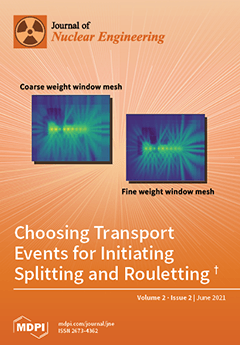Modal expansions based on
k-eigenvalues and
α-eigenvalues are commonly used in order to investigate the reactor behaviour, each with a distinct point of view: the former is related to fission generations, whereas the latter is related to time. Well-known Monte Carlo
[...] Read more.
Modal expansions based on
k-eigenvalues and
α-eigenvalues are commonly used in order to investigate the reactor behaviour, each with a distinct point of view: the former is related to fission generations, whereas the latter is related to time. Well-known Monte Carlo methods exist to compute the direct
k or
α fundamental eigenmodes, based on variants of the power iteration. The possibility of computing adjoint eigenfunctions in continuous-energy transport has been recently implemented and tested in the development version of TRIPOLI-4
®, using a modified version of the Iterated Fission Probability (IFP) method for the adjoint
α calculation. In this work we present a preliminary comparison of direct and adjoint
k and
α eigenmodes by Monte Carlo methods, for small deviations from criticality. When the reactor is exactly critical, i.e., for
k0 = 1 or equivalently
α0 = 0, the fundamental modes of both eigenfunction bases coincide, as expected on physical grounds. However, for non-critical systems the fundamental
k and
α eigenmodes show significant discrepancies.
Full article




